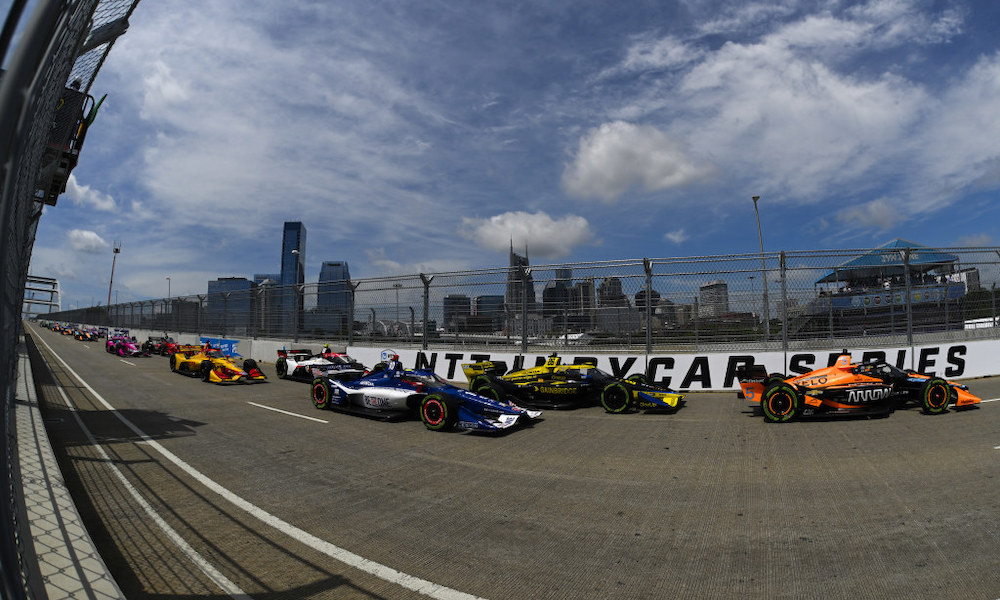Nashville failed to live up to expectations on Sunday, and that’s a delightful thing to report.
Dubbed ‘Crashville,’ and rightly so after its first two events had more in common with destruction derbies than NTT IndyCar Series races, the race that took place during Sunday’s 80-lap contest won by Kyle Kirkwood was, for the first time, downright normal.
It’s the race Nashville’s promoters have been hoping for since its debut in 2021, and after rain and big swings in temperature and humidity brought the potential of another calamity, the Music City GP finally delivered a street circuit contest that was no different from its counterparts in Detroit or Toronto.
Sunday’s race also proved that a big field of 27 cars — which is expected again in 2024 — can put on a good show without emptying the pace car’s fuel tank.
According to the official race report, there were four cautions and a red flag, but the first three yellows can be ignored since they were unremarkable. Only the fourth, a multi-car pileup at Turn 11 on the lap 75 restart that quickly went red, was unique to the Nashville event. It’s here where it’s time to bow our heads and have a moment of silence for a stretch of road that caused more mayhem than any other on the IndyCar calendar.
With the new and shorter Nashville layout coming in 2024, Turns 10-11 are relegated to history, and if you’re an IndyCar mechanic, this is wonderful news. In this short section of road alone, we saw Marcus Ericsson briefly fly before going onto win the inaugural race, witnessed countless solo crashes and wall-banging incidents, and watched red flag after red flag fly as drivers used Turn 11 as their personal mosh pit.

Its loss, in the upcoming seven-turn 2.17-mile layout that deletes everything from the existing Turn 9 through Turn 3 complex, brings a sigh of relief. But next year’s course, which relies heavily on a new run through downtown Nashville, isn’t exactly a worry-free design; the extra-long blast from Turn 1 onto the bridge and the hairpin waiting at the other end brings Long Beach to mind if the field went the opposite direction on Shoreline Drive and arrived at the Turn 11 hairpin at 190 mph. What could go wrong?
The concerns raised over holding the final race of the championship at a track that’s known for a high rate of crashes are valid, but we’ll need to wait and see if my old Golden Bowling Ball award gets handed out to multiple drivers for throwing strikes in Nashville, or if the fourth installment of the event goes down like the third where an afternoon of mostly good behavior was the welcome takeaway.
And kudos to IndyCar for moving Nashville to the season-ending slot on the calendar.
Back in the 1990s when I was a crew member on Indy Lights and IndyCar teams, Laguna Seca was often the site of the season finale, and in those wildly popular days, the track was packed with fans. Whether it was Michael Andretti in 1991, Nigel Mansell in 1993, or local hero Jimmy Vasser in 1996, we had a true feeling of celebration among the teams and fans when new champions were crowned. The banquets and after parties were also something to behold. I have solid memories of getting dressed and arriving at a few of them, but the rest is rather foggy.
With the small crowds we’ve seen in recent years since IndyCar returned to Monterey as the place where its championship showdown is held – despite the increases we’ve seen in attendance – there just hasn’t been the volume of fans to make the crowning of new title winners feel special in the same explosive way it did in the past. As much as I’d love to see the tradition continue at my home track, the more IndyCar can make itself look and feel special, the better, and that wasn’t on the horizon with Laguna Seca as the last stop on the schedule.
Taking the party to Nashville, where celebrating is the town’s singular focus, is among the smartest things I’ve seen the series do since it was purchased by Penske Entertainment.
